International Journal of Engineering and Manufacturing @ijem
Статьи журнала - International Journal of Engineering and Manufacturing
Все статьи: 550
Vehicle Object Tracking Based on Fusing of Deep learning and Re-Identification
Статья научная
Object tracking is a popular problem for automatic surveillance systems as well as for the research community. The requirement of an object tracking problem is to predict the output including the object position at the current frame based on the input the position of the object at the previous frame. To present the comparison and experiment of some object tracking methods based on deep learning and suggestions for improvement between them in this paper, we had taken some important steps to conduct this research. First, we find out the studies related to deep learning-based object tracking models. Secondly, we examined image and video data sets for verification purposes. Thirdly, to evaluate the results obtained from existing models, we experimented with a little work related to object tracking based on deep learning networks. Fourth, based on the implemented object tracking models, we had proposed a combination of these methods. And finally, we summarize and give the evaluations for each object tracking model from the results obtained. The results show that object tracking based on Siammask model has the highest results TO score of 0.961356383 on VOT dataset and 0.969301864 on UAV123 dataset, but the possibility of errors is also high. Although the result of the combined method has few scores those are lower than the object tracking based on Siammask model, the combined method is more stable than the object tracking based on Siammask model when TME score of 16.29691993 on VOT dataset and 10.16578548 on UAV123 dataset. The Vehicle ReIdentification method results have scores that are not too overwhelming. However, the TME score is the highest with the TME score of 11.55716097 on the VOT dataset and 4.576163526 on the UAV123 dataset.
Бесплатно
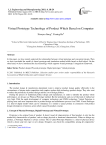
Virtual Prototype Technology of Product Which Based on Computer
Статья научная
In this paper, we have mainly analyzed the relationship between virtual prototype and concurrent design. Then we have concluded the model of virtual prototype and simulation method which based on field object. On the other hand, we have introduced the key technology which supports virtual prototype’s integration framework.
Бесплатно
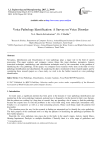
Voice Pathology Identification: A Survey on Voice Disorder
Статья научная
Nowadays, Identification and Classification of voice pathology plays a major role in the field of speech processing. This paper explores and compares various things like input database, parameters, features extraction techniques, methodology and classification techniques used by the researchers in the problem of identifying the voice pathology. In this paper, we compared seven research works done in the field of voice pathology identification and classification. By analyzing the data's mentioned in these research papers and by considering these research papers as a base study, we wish to do the further research on voice pathology identification.
Бесплатно
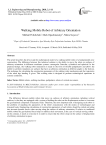
Walking mobile robot of arbitrary orientation
Статья научная
The article describes the device and the mathematical model of a walking mobile robot of a fundamentally new construction. The difference between this technical solution is the ability to move the robot on surfaces of arbitrary orientation in different coordinate systems: rectangular Cartesian, cylindrical and spherical. In the proposed design, the walking robot mechanism is made in the form of flexible pedipulators and allows the mobile to perform transitions on surfaces that have an arbitrary orientation at different angles to the horizon. The technique for calculating the construction parameters of the walking robot mechanism and the trajectories of the robot legs bending is given. This walking robot is designed to perform technological operations in extreme conditions.
Бесплатно
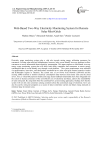
Web-Based Two-Way Electricity Monitoring System for Remote Solar Mini-Grids
Статья научная
Electricity usage monitoring systems play a vital role towards raising energy utilization awareness for consumers. Existing solar mini-grid infrastructure, however, lacks a user-friendly two-way platform to allow consumers to access information about electricity consumption. This paper proposes a cloud-based, two-way energy usage monitoring system that will allow both utility companies and consumers to access energy consumption data in a user-friendly way through a web platform. The system requirements were collected via questionnaires, interviews, and observations conducted at two solar mini-grids centres located at Arusha and Kilimanjaro regions in Tanzania. The system uses a Low Power Area Network (LPWAN) and the existing GPRS network to monitor electricity consumption data between smart meter units and the cloud server. Also, a virtual bill payment module and usage status feedback functionality have been integrated into the system to increase awareness of the cost-effective use of electricity and hence, achieve the sustainability of solar mini-grids. By using both white-box and black-box system testing approaches, findings show that the system will not only raise awareness among customers about the economical usage of electricity, but it can also be used by mini-grid companies as a source of data to determine current and future energy demands to minimize large investment costs.
Бесплатно
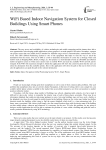
WiFi Based Indoor Navigation System for Closed Buildings Using Smart Phones
Статья научная
The easy access and availability of wireless technologies and mobile computing and the internet have led to new opportunities in developing mobile applications whose purpose is to make people’s life easier. Nowadays, a person can possess more than one mobile device intended for different usage such as communication, entertainment, office work. This GPS (Global Positioning System) is one of the equipment that helps to find the way to reach the destination from the source. The use of GPS as a tool to determine the location of course has a shortage when used indoors such as Shopping Malls, Hotels, College, etc. Our project is a small attempt towards an affordable and efficient indoor navigation system in which users need to turn on mobile Wi-Fi and scan the available Wi-Fi network and its strength. If the WiFi with maximum strength is found then application will show the current location then the user can select the destination from the available options. Due to this application will show the path to the user in form of text also the application can speak the path to the selected destination
Бесплатно
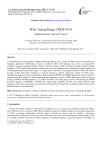
Статья научная
A communication system requires a highly stabilized frequency; LC and RC oscillator are two wide option for frequency generation. Performance of an LC oscillator suffers from leakage, area, noise etc compare RC oscillator. Voltage controlled oscillator (VCO) is preferred category if RC oscillator to generate high oscillator frequency. VCO contains odd number of delay stage cascaded together; output frequency strongly depends on switching threshold of individual stages. A 3 stage current starved VCO can generate upto 0.6 Ghz; this work is focused around body bias technique to increase frequency without increasing number of delay stage. Oscillation frequency has been controlled by bulk terminal of PMOS and NMOS individually and by means of adaptive body bias network. Cadence spectre based simulation result at CMOS 90nm shows that by reverse biasing of PMOS obtained frequency is 1.2GHz-10.01GHz with tuning range of 95% while biasing of NMOS generate frequency of 500MHz- 12.5GHz with tuning range capability of 96%. This design presents high frequency with wider tuning range and optimum reduced power by which this oscillator design can be used in different band of communication.
Бесплатно
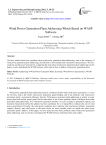
Wind Power Generation Plant Addressing Which Based on WASP Software
Статья научная
We have studied some basic problems about wind power generation plant addressing, such as the economy of wind power generation plant addressing, the affection of environment and wind power characteristics. We have analyzed and discussed seriously by comparing the steps about wind power generation plant addressing. In this paper, we also introduced the WASP software which used to how to address wind power generation plant.
Бесплатно
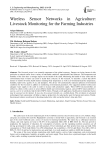
Wireless Sensor Networks in Agriculture: Livestock Monitoring for the Farming Industries
Статья научная
The livestock sector is an essential component of the global economy. Farmers are losing interest in this profession as animals suffer from a variety of bad health conditions, unpredictable fatal illnesses. The temperature and humidity of the farm have a stronger impact on the health of the cattle. Monitoring the health of dairy cattle and the environmental state of farms can assist to tackle these concerns. In this research, we describe a system that allows farmers to monitor livestock health metrics including body temperature as well as environmental data like temperature, humidity, light levels, quality of air, and dampness. The device will automatically maintain optimum environmental conditions for the livestock in addition to monitoring environmental parameters. Our suggested method would assure adequate water supply to the cattle in order to increase milk production supply. Three ESP32 microcontrollers are utilized as clients in this system to sense different health and environmental aspects, and an ESP32 microcontroller is used as a server to wirelessly link the three ESP32 clients. Through a web application, health and environmental factors may be accessed on the internet. It may also be accessed remotely on a mobile phone. This revolution in advanced technological farm automation will help to improve productivity by reducing the need for human intervention. Finally, the proposed solution would assist in boosting productivity while saving the farmer's time and effort.
Бесплатно
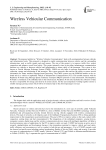
Wireless Vehicular Communication
Статья научная
The proposal entitled as “Wireless Vehicular Communication” deals with communication between vehicles and infrastructural units. This proposal is designed to enable communication between vehicles and the surrounding infrastructure, such as traffic signals and road sensors. The aim of this project is to improve traffic flow, reduce congestion and enhance overall road safety. This project primarily aims at providing instantaneous communication between two vehicles or between vehicles and infrastructure to ensure safety of the passenger. This system is also known as Crucial Message Exchange System (CMES). CMES not only helps in message transmission but also in collection, storage and monitoring of the messages. This system processes data and has the ability to extract crucial information for future machine language-based processing. The CMES system uses the ESP8266 module as the on-board unit in a vehicle to implement Vehicle to Infrastructure Communication (V2I). This module interacts with the Raspberry Pi board using Message Queue Telemetry Transport (MQTT) protocol to relay information. The Raspberry Pi board is considered as the embedded unit in the infrastructure. Raspberry Pi not only facilitates the collection of data but also is responsible for storage and retrieval in cloud systems. All the said components working together ensures a reliable message passing system which will be of immense help to the drivers/passengers on road.
Бесплатно

